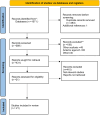Low-density pedicle screw in adolescent idiopathic scoliosis: a systematic review and meta-analysis of 1,762 patients
- PMID: 40809532
- PMCID: PMC12343578
- DOI: 10.3389/fsurg.2025.1607323
Low-density pedicle screw in adolescent idiopathic scoliosis: a systematic review and meta-analysis of 1,762 patients
Abstract
Background: High-density pedicle screws provide satisfactory correction in adolescent idiopathic scoliosis (AIS) but add to the operative time, blood loss, and cost; low-density constructs may mitigate these burdens and achieve similar correction results. Studies use inconsistent density cutoffs (most often <1.6 screws/level) and report conflicting results; therefore, we performed a systematic review and meta-analysis to clarify the clinical, radiographic, and economic impact of low screw density in patients with AIS.
Methods: A systematic review and meta-analysis were conducted following PRISMA guidelines. The PubMed, Web of Science, and Embase databases were searched until December 2024 for comparative studies. The outcomes analyzed included surgical and safety parameters (blood loss, operative time, revision rates, and complications), radiographic outcomes (Cobb angle, correction rate, and thoracic kyphosis), and implant costs. Statistical analyses were performed using RevMan 5.4, with fixed- or random-effects models applied on the basis of heterogeneity (I² threshold < 50%).
Results: Twenty-one studies comprising 1,762 patients met the inclusion criteria. Low-density screws were superior in reducing blood loss [mean difference (MD) = -88.06, P = 0.01] and operative time (MD = -22.27, P = 0.02), with no significant difference in revision rates (P = 0.78) or complications (P = 0.64). No differences were observed between the groups in the final Cobb angle (P = 0.4), Cobb correction rate (P = 0.21), or thoracic kyphosis (P = 0.43). The per-level implant cost was lower (standard mean difference = -1.32, P < 0.00001) in the low-density group.
Conclusion: Compared with high-density screws, low-density pedicle screws provide comparable radiographic and safety outcomes while reducing the operative time, blood loss, and cost. These findings support the use of low-density constructs in AIS surgery, although the variability in study designs and screw density definitions warrants further research. Future multicenter randomized controlled trials are needed to refine the optimal screw density strategies for treating AIS.
Systematic review registration: https://www.crd.york.ac.uk/PROSPERO/view/CRD420251088403, PROSPERO CRD420251088403.
Keywords: adolescent idiopathic scoliosis; deformity; high density; low density; screw density.
© 2025 Zheng, Zhou, Liu, Ma and Qiang.
Conflict of interest statement
The authors declare that the research was conducted in the absence of any commercial or financial relationships that could be construed as a potential conflict of interest.
Figures










Similar articles
-
Does higher screw density improve radiographic and clinical outcomes in adolescent idiopathic scoliosis? A systematic review and pooled analysis.J Neurosurg Pediatr. 2017 Apr;19(4):448-457. doi: 10.3171/2016.11.PEDS16334. Epub 2017 Feb 3. J Neurosurg Pediatr. 2017. PMID: 28156215
-
Intraoperative image guidance compared with free-hand methods in adolescent idiopathic scoliosis posterior spinal surgery: a systematic review on screw-related complications and breach rates.Spine J. 2017 Sep;17(9):1215-1229. doi: 10.1016/j.spinee.2017.04.001. Epub 2017 Apr 17. Spine J. 2017. PMID: 28428081
-
Pedicle screw versus hybrid instrumentation in adolescent idiopathic scoliosis: A systematic review and meta-analysis with emphasis on complications and reoperations.Medicine (Baltimore). 2017 Jul;96(27):e7337. doi: 10.1097/MD.0000000000007337. Medicine (Baltimore). 2017. PMID: 28682881 Free PMC article.
-
Efficacy and Safety of Low-Density Pedicle Screw versus High-Density Screw in Lenke I Scoliosis: A Systematic Review and Meta-Analysis.World Neurosurg. 2025 Jan;193:79-90. doi: 10.1016/j.wneu.2024.10.029. Epub 2024 Nov 4. World Neurosurg. 2025. PMID: 39414137
-
Minimally invasive surgery using posterior-only Pedicle screw fixation in treatment of Adolescent Idiopathic Scoliosis: A Systematic Review and Meta-Analysis.J Clin Neurosci. 2022 May;99:317-326. doi: 10.1016/j.jocn.2022.03.019. Epub 2022 Mar 24. J Clin Neurosci. 2022. PMID: 35339852
References
-
- Lehman RA, Jr, Lenke LG, Keeler KA, Kim YJ, Buchowski JM, Cheh G, et al. Operative treatment of adolescent idiopathic scoliosis with posterior pedicle screw-only constructs: minimum three-year follow-up of one hundred fourteen cases. Spine. (2008) 33(14):1598–604. 10.1097/BRS.0b013e318178872a - DOI - PubMed
Publication types
LinkOut - more resources
Full Text Sources
Miscellaneous

